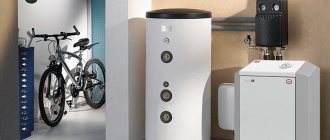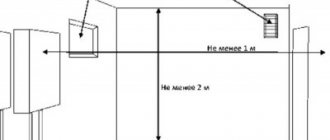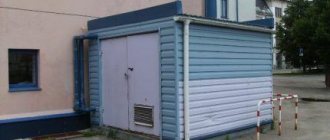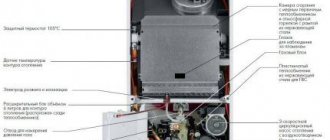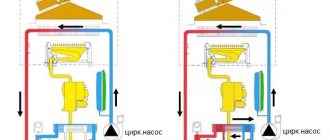Home / Gas boilers
Back
Published: 11/15/2019
Reading time: 5 min
1
27155
Many homeowners are happy to install gas boilers indoors for heating and hot water supply, so as not to depend on the whims of bad weather and pitfalls associated with the operation of municipal heating systems.
In this situation, the correct choice of boiler equipment is of great importance, for which you will need to know how to calculate the power of a gas boiler.
If it exceeds the actual heat loss of the facility, then part of the cost of generating thermal energy will be lost. And units with low heating capacity will not be able to provide households with the required amount of heat.
- 1 What is the power of a gas boiler
- 2 Calculation of the power of a gas boiler depending on the area 2.1 Calculation of a single-circuit heating boiler
- 2.2 How to calculate the power of a double-circuit boiler
- 2.3 Calculation of the power of an indirect heating boiler
Description of the parameter and factors influencing power
The correct choice of boiler should be based on accurate knowledge of the heat losses of the house. Excessive power will lead to excessive consumption of natural gas, and its lack can cause rapid equipment breakdown. Factors influencing the determination of the main indicator of a heating device:
- climate zone;
- heated area;
- DHW consumption;
- volume of living space;
- thermal conductivity of walls, ceilings;
- the presence of an attic, attic, basement;
- type and scheme of ventilation in the building.
The walls must be thermally conductive.
Calculations without taking these parameters into account are approximate with a deviation in one direction or another by 50% or more.
Requirements for the indicator
The main requirement for the main characteristics of the equipment is that its power corresponds to the optimal value for the apartment and the existing conditions. Deviation from it should be minimal. There are also additional requirements depending on the value of the calculated value:
- for devices with P < 30 kW, the required ceiling height is more than 2.2 m;
- for devices with P > 30 kW, the height of the premises is not less than 2.5 m;
- for several units the distance between them and the wall is at least 1 m, for 1 device between its front part and the opposite wall is also at least 1 m;
- its upper part should be 0.7 m from the ceiling;
- the width of the door in a room with a heating device is at least 0.8 m;
- walls, doors, partitions in the boiler room must be fire-resistant and resistant to steam and gases;
- the area of the boiler room with any type of installation is at least 4 m² while maintaining visibility;
- the room must have separate exits to the outside to ensure the removal and supply of air from the street;
The volume of the boiler room directly depends on the power of the heating equipment:
- for P <= 30 kW - more than 7.5 m³;
- for P from 30 kW to 80 kW - up to 15 m³;
- for P from 80 kW to 200 kW - over 15 m³.
The volume of the boiler room should be selected.
It is strictly not recommended to connect the equipment yourself.
Regional climate and correction factor
Depending on the climate zone in which the boiler will operate, the following amendments are applied:
- Far North: over 2.0;
- Eastern Siberian regions: 2.0;
- Western Siberian regions and the south of the Far East: 1.8;
- northwestern region and Moscow region 1.5;
- middle band 1.2;
- south of the country 0.8.
For a more accurate thermal calculation of the power of a gas boiler for a private house, average monthly temperatures and the wind rose for a specific area are used.
To determine how much power a gas boiler needs, you can use either a simple estimation formula or delve into complex thermal calculations. In this case, a lot of calculated data is used. Since heating gas boilers are produced with a certain power step, you need to stop at the nearest one, greater than the calculated one.
Calculation of gas boiler power depending on the area of the house
Using the specific thermal power coefficient provides the fastest way to determine equipment parameters. Multiplying the standard heat loss of 1 m² by the total heated area gives the required value. Taking into account construction technologies and climatic zones, the average heat consumption of a residential premises is taken at the level of 100 W/m² or 1 kW per 10 m². If the building parameters deviate from the standard ones or the need for hot water supply, it is necessary to recalculate the power of gas equipment.
The average heat loss per square meter of surface varies depending on the climate, the regional coefficient is:
- 0.7 - 0.9 for the southern regions of the Russian Federation;
- 1.0 - 1.15 in central Russia;
- 1.2-1.5 for the Moscow region;
- 1.5 - 2.0 for territories beyond the Arctic Circle.
For a single-circuit boiler
A simplified calculation of the power of a 1-circuit device, in a floor-standing or wall-mounted version, is based on the coefficient 1 m² = 100 W of energy. The resulting value is increased by 20% to create a reserve. If necessary, a climate zone correction factor can be applied. So, for a house area of 100 m² you will need a boiler of 12 kW = 10 kW + 2 kW. The calculations do not include the hot water supply system, heated floors and other consumers of thermal energy.
Connecting a single-circuit boiler.
For a double-circuit boiler
When designing a heating system, you should not get carried away with excessive calculation accuracy. The question of how to calculate the power of a gas boiler with 2 circuits will not arise if you use the standard method. Finding out the exact room temperature using a simplified method is problematic. It only allows you to determine what power reserve should be in order to provide heat to all consumers.
Heating energy is calculated using a coefficient of 1 m² = 100 W. A 20% reserve is added to the value and an additional 20% to increase the water temperature. For a house with an area of 100 m², the required power of a double-circuit heater will be 10 kW + 2 kW + 2 kW = 14 kW.
For boiler
First, the maximum hot water flow is set, which is calculated by summing the productivity of each water intake point:
- bath - 8-9 l/min;
- shower - 9 l/min;
- washbasin in the toilet - 4 l/min;
- kitchen sink - 4 l/min.
The boiler's manual determines the boiler's performance and the volume of the water heating tank. For the given indicators, you will need a storage tank of 200 liters and a 30 kW heater. This value is summed with the heating power and 20% is subtracted P0 = (P(boiler)+P(boiler)-20%. We obtain the total P0 for the entire system.
Boiler power for heated floors
Determining the power of a gas boiler for a heated floor is no different from those described above. As in the previous case, the boiler is selected according to the heat loss of the house. The most popular type of system includes pipes with a standard diameter of 16 mm and a standard distance between pipes of about 150 mm. Most underfloor heating systems are rated to heat up to 55 degrees Celsius, but this may vary depending on many factors such as floor type, environment, etc.
Calculation of kW requirements will also depend on the type of floor:
- 70 W per m2 for wooden floors;
- 100 W per m2 for concrete floors.
If you wanted to heat a 6mx4.5m (27m2) wooden floor, you would simply multiply 27x70 = 1890. That's 1890W or 1.89kW.
Formula for calculating the volume of a room
SNiP makes it easier to determine the power of a heating device based on the footage of the building. This method worked well in calculations for rooms with non-standard layouts (2-storey, high ceilings). To calculate, you need to know the parameters of each room separately and the entire building. According to the methodology given in SNiP 02.23.2003 “Thermal protection of buildings”, the heat loss coefficient of 1 m³ for an apartment building, kilowatt:
- made of brick - 0.034 kW/m³;
- from panels - 0.041 kW/m³.
Brick room.
Knowing these coefficients, the area and height of the ceilings, it is possible to calculate the boiler power by the volume of the room. In a panel house, heating an apartment of 125 m² and a ceiling height of no more than 2.7 m will require a minimum power of 2.7 * 125 * 0.041 = 13.84 kW. Since devices with such characteristics are not produced, you should purchase equipment with the closest value - 12 kW.
Coolant speed
Then, using the obtained coolant flow values, it is necessary for each section of pipes in front of the radiators to calculate the speed of water movement in the pipes using the formula:
,
where V is the coolant movement speed, m/s;
m is the coolant flow through the pipe section, kg/s
ρ—density of water, kg/cub.m. can be taken equal to 1000 kg/cub.m.
f - cross-sectional area of the pipe, sq.m. can be calculated using the formula: π * r2, where r is the internal diameter divided by 2
Coolant velocity calculator
m = l/s; pipe mm by mm; V = m/s
The most accurate calculation taking into account all the features of the house
For a person who is not an expert in building heating systems, the best option would be to use a power calculator. Equipment manufacturers are interested in the correct operation of the equipment they sell, minimizing its returns and receiving positive feedback. Therefore, in such calculation methods they take into account as many factors as possible that determine the thermal design of the building.
When calculating the boiler power using a calculator program, you must enter the following parameters:
- required temperature in the building;
- maximum flow;
- minimum outdoor readings during the heating season;
- room heights;
- number of floors;
- type and size of windows;
- thermal conductivity of walls, floors between floors;
- presence of forced ventilation.
Substituting the collected information into the program for calculating thermal power, we obtain the desired value. If the answer is unsatisfactory, the parameters are selected (if it is physically possible to change) until the desired value is obtained.
Gas boiler power for hot water supply
The common belief of the majority is “I have a big house, I need a huge gas boiler.” Boiler power is measured in kW (kilowatt). Basically it is a way of measuring the amount of heat from a boiler.
Hot water requirement
One of the factors that determines the power of a gas boiler for domestic hot water supply is the pressure in the system. If you have an older heating system and want to switch to a gas boiler, make sure the boiler is sized for the system voltage and pressure. For example, if you have a tank and 2 bathrooms, with the right system you can use all the faucets at the same time. If you want to remove the tank and install a combi boiler, you are likely to encounter a problem as both taps exceed the flow allowed by the system and the boiler's capabilities.
Determining the power of a gas boiler for hot water supply is quite difficult. It is important to understand that a minimum of 24 kW of boiler power is required in order to produce the required amount of hot water. This is 12-14 liters.


